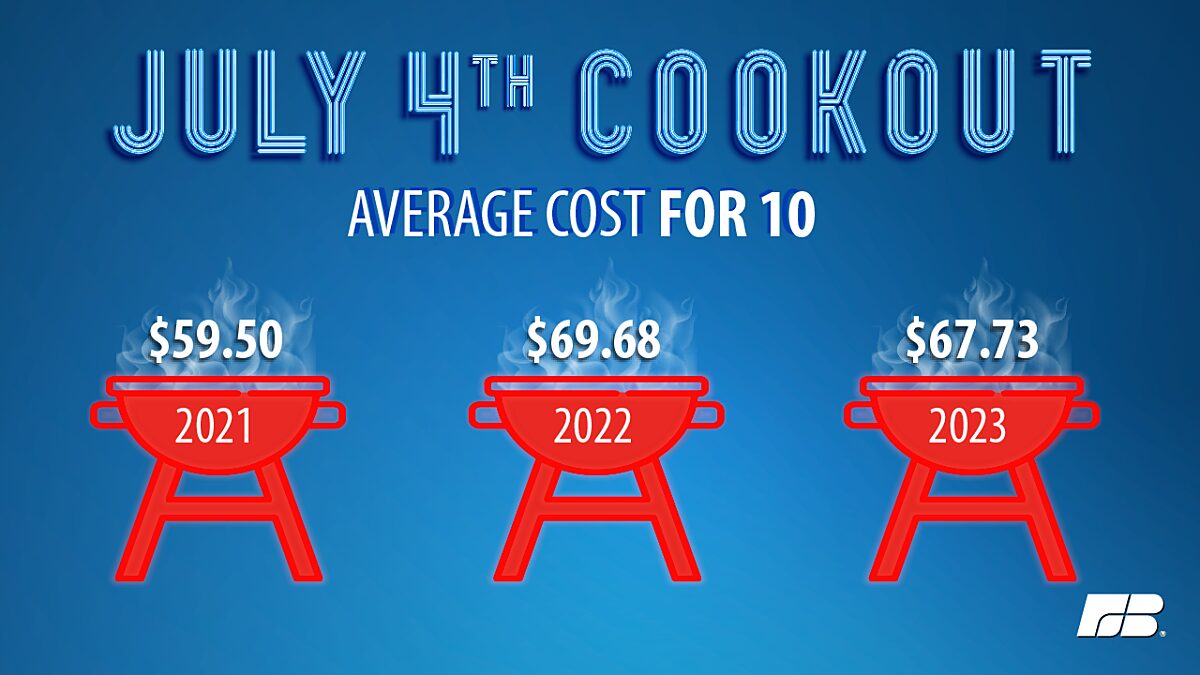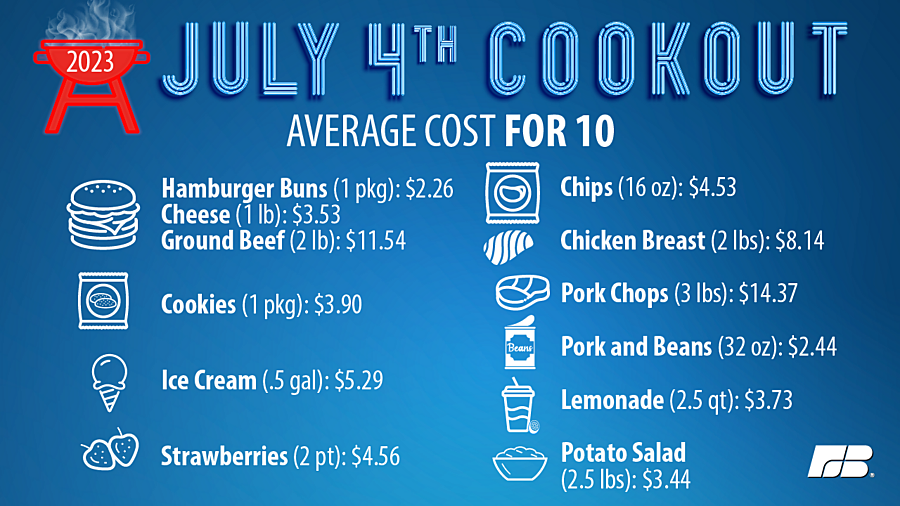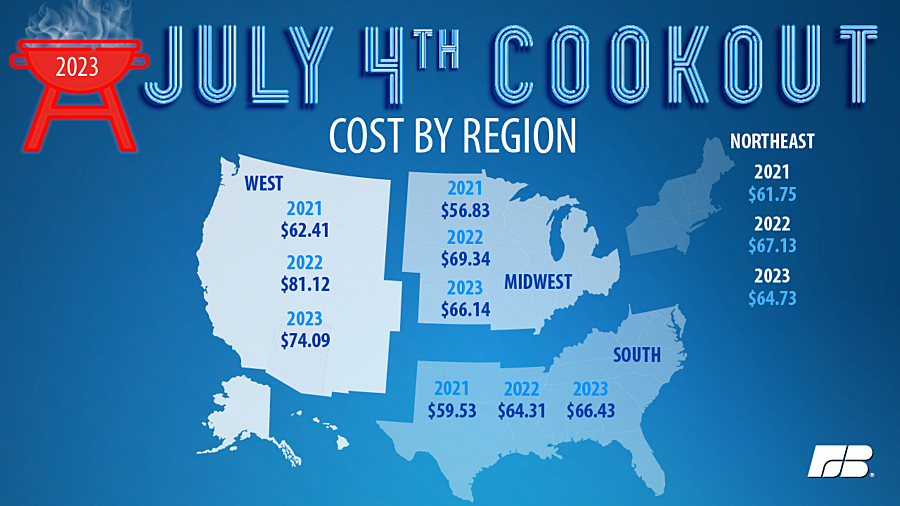July 4th Cookout Costs Down Slightly from Record-High in 2022

Nick Althoff
Economics Intern
Daniel Munch
Economist
It’s that time of year again! Families and friends will be gathering to celebrate Independence Day! As Americans prepare for a day filled with fireworks, food, and fun they will be reminded of the effects of persistent food price inflation.
According to data from the American Farm Bureau’s annual Fourth of July marketbasket survey, conducted by volunteer shoppers from across the country, consumers can expect this year’s Fourth of July cookout to cost $67.73, which is down 3%, or $1.95, from last year’s all-time high of $69.68. Although the cost of a 10-person cookout, which includes cheeseburgers, chicken breasts, pork chops, potato chips, pork and beans, fresh strawberries, homemade potato salad, fresh-squeezed lemonade, chocolate chip cookies, and ice cream, has decreased since last year, the cost remains 14% higher than in 2021. Half of the surveyed foods decreased in average price compared to a year ago, while five increased, and one remained unchanged. Compared to 2021, prices for eight of the twelve food products increased over two years. Although food prices remain inflated, the total cost breakdown is less than $7 per person, at $6.77.
The Main Dish
Combined, the chicken breasts, pork chops, and hamburger meat account for over 50% of the cost of the summer cookout, showing how much the meat case influences the overall cost of the cookout.
Chicken and pork survey prices are lower compared to last year. In the case of chicken, survey results showed two pounds of chicken breasts at $8.14, down 9% from last year but up 21% from 2021. The recent drop in poultry product prices is attributable to a decrease in avian influenza cases and the resulting recovery in layer and broiler flock populations. Generally, the more broilers available to the supply chain the lower the price for consumers at the grocery store. Next, three pounds of pork chops will cost $14.37, down 6% from last year’s survey; however, the price remains 24% higher than in 2021. The slight decrease likely stems from recent increases in hog slaughter; however, the price remains inflated due to higher feed and transportation costs. Finally, the survey had ground beef up 4% from last year, likely due to the higher feed costs and decreased herd sizes resulting from drought conditions. Many farmers liquidated cattle herds in the face of abysmal forage conditions which initially decreased beef prices. Once consumers worked through the lower-priced excess supply the resulting beef replacement herd was 6% smaller than in 2022. Until the breeding herd recovers, beef prices will remain elevated.
Pass the Sides
When considering further processed food items it is essential to remember the smaller role direct agricultural market conditions have in the final retail price. Additional rounds of value add through further processing, the use of additional ingredients and role of promotional efforts by retailers lowers the impact of farm economics on what consumers pay at the register. With this in mind, hamburger buns showed the highest price increase in the cookout market basket. Survey results showed a bag of hamburger buns cost $2.36, up 17% from last year. The increased survey price may have been influenced by depressed drought-linked wheat yields, increased consumption, and higher manufacturing costs. Discounts by certain retailers may also have played a role. Many consumers are likely familiar with reduced priced chips, salsa, hamburger and hot dog buns being placed by entry doors of their favorite retail outlet during summer cookout season.
The cost of homemade potato salad is derived from the prices of potatoes and eggs. The cost of potatoes is up 26% in 2023 compared to 2022, thanks to weather-related production decreases and growing U.S. potato exports to key partners like Mexico. Unlike potatoes, the surveyed price of eggs is down 24% compared to 2022 but up 35% in 2023 compared to 2021, as flocks recover during an easing of the avian influenza, noted above. Egg prices remain high compared to historical eggs prices.
The cost of fresh-squeezed lemonade is down 16% from last year. Though the cost of sugar is rising, the cost of lemonade is decreasing with the price of lemons, which were down 23% in 2023 compared to 2022 and down 5% compared to 2021. The cost of sugar is up 21% in 2023 compared to 2022 and up 32% compared to 2021.
All-milk prices have reached their lowest levels since October of 2021. Healthy supplies of cheese atop ever-increasing processing capacity combined with weaker demand are expected to drive the cost of dairy products down for the foreseeable future. Even with this backdrop, survey results showed American cheese remained the same price as last year at $3.53 and that a half-gallon of ice cream is up 3%. Usually located at the back of the store, retailers may be banking on reduced price sensitivities by consumers during the cookout season and maintained higher comparative prices as the farm received price declined.
The cookout staple of pork and beans is down 3% in 2023 relative to 2022 but up 28% relative to 2021. Finally, the particular brand of chocolate chip cookies that our volunteers are asked to price is down 11% this year compared to 2022, due perhaps to a company promotion.
Let’s Get Regional
The survey results revealed regional differences in retail food prices, with a $9.96 spread from highest to lowest. The most expensive regional cookout is in the West at $74.09, followed by the South at $66.43, the Midwest at $66.14, and the Northeast was the most affordable at $64.73.
Other Considerations
From a global viewpoint, despite food inflation and supply chain problems, food is more affordable in the U.S. than in many other countries. The average U.S. consumer spends roughly 7% of their disposable income on food, while consumers in some countries pay over 50%. For instance, residents of Bangladesh and Nigeria can expect to spend 53% and 59% of their income annually on food, respectively. Canadians pay a closer 10% and in China, residents pay about 20% of their income on food annually.
Part of the reason food prices in the United States remain comparatively low is the presence of effective risk management and safety net programs that help stabilize agriculture markets and revenues farmers receive in an inherently uncertain and volatile industry. Many of these programs are defined and authorized by the farm bill, the latest of which is set to expire Sept. 30, 2023. The farm bill provides an important consistent opportunity for policymakers to address agricultural and food issues comprehensively. It has grown over the decades to serve food and agriculture, but its roots are in farm commodity program support. These traditional support commodities include corn, cotton, wheat, soybeans, rice, dairy, peanuts, and sugar. The farm bill has expanded and broadened to include nutrition assistance, conservation, research, specialty crops and bioenergy programs. Because of this, the farm bill brings together some of the most unlikely partners to advocate for a legislative package composed of provisions that would likely not survive the legislative bureaucracy as stand-alone measures.
On the farm side, those utilizing farm bill programs value risk management tools that offer certainty and predictability. Tools like crop insurance products, marketing loans and commodity programs help producers manage through tough times. Voluntary, market-based incentives in conservation programs help provide producers with the tools and assistance needed to implement soil and water improvements. Rural communities have access to tools like broadband grants and new business loans authorized by the farm bill to help enhance economic development and attract growth.
On the nutrition assistance side, many families are able to put dinner on the table thanks to farm bill programs like the Supplemental Nutrition Assistance Program (SNAP).
Just as agriculture changes and adapts to meet the needs of the time, the farm bill must do the same to serve the needs of its constituents. Every five years or so, Congress prioritizes the passage of a new farm bill to meet the challenges of an ever-changing world and ensure that critical programs continue to work for farmers and ranchers, families on a budget, and rural communities working to stay competitive.
This year, the same factors that have led to inflated prices for food and for all the things that farmers have to buy to produce that food have raised new challenges for the farm bill.
Conclusion
Survey results show that 2023 yielded the second most expensive 4th of July cookout in the survey’s history, behind 2022. Although survey prices have begun to come down, food price inflation remains a real issue and serves as a constraint on the budget of all U.S. consumers. Despite challenges with inflation and the rising cost of food, farmers and ranchers are working hard each day to provide America with a safe and affordable food supply. Food security plays a significant role in national security. Having an abundant and reliable food supply is essential for any free nation. Through the 2023 farm bill, like its predecessors, Congress will undoubtedly provide critical support to farmers and the American people through risk management, conservation, agricultural research, nutrition assistance, and much more. So, this Fourth of July, as you fire up the grill for your annual cookout, think of the hard work of farmers and ranchers in providing our food and the national security and well-being that go with it.
Top Issues
VIEW ALL

